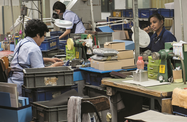Record-breaking sales in 2010 have seen Malaysia’s automotive industry racing along in recent times. Moderation in demand and government policies, however, may see growth shift down a gear in 2011.
In 2010 new registrations totalled 605,156 units, according to the Malaysian Automotive Association, up almost 10% from the previous record of 552,316 units in 2005.
Year-on-year (y-o-y) growth in 2010 was 12.7%, with sales of passenger vehicles growing 11.8% to 543,594 and sales of commercial vehicles up 21.8% to 61,562 units. The record vehicle sales in 2010 were mainly attributed to the improved economic conditions and overflow sales from new models launched in 2009.
Expansion is expected to be slower in 2011, however, on the back of a reduction in economic growth. Indeed, on January 5, industry research firm Frost & Sullivan said it projects Malaysia’s total volume will increase at a moderate pace of 4.1% y-o-y to 623,000 units in 2011. Within this overall figure, sales of passenger cars are forecast to maintain expansion of 2.1%.
The star of the Malaysian auto show these days is undoubtedly Perodua, a joint venture between Malaysian and Japanese partners established in 1993.
Perodua announced on January 12 that its sales had jumped 13% in 2010 to a new high, helping it to retain its leadership in the industry for the fifth straight year, with a 31.2% market share. Perodua overtook national carmaker Proton as the leading car brand in Malaysia in 2006.
Perodua’s Myvi was Malaysia’s top-selling car in 2010, while the Alza, which the company debuted in late 2009, was the best-selling multi-purpose vehicle (MPV). The firm is said to be planning to launch a new model in 2011.
Proton came in second place with a 26% market share. The third, fourth and fifth places were held by Toyota with 15.1%, Honda with 7.4% and Nissan with 5.7%, respectively.
As well as being the top seller, Perodua also produced the most vehicles locally, with 197,479 units made in Malaysia. This is followed by Proton with around 170,000 units and Toyota with 61,741. Local production of passenger vehicles overall grew 16.9% to 522,568.
At the same time, international brands are also doing well in Malaysia. On January 11, BMW Group Malaysia announced its sales in the country had reached record highs. The group, comprising BMW, MINI and BMW Motorrad, together sold 4509 vehicles in 2010, the highest level since its establishment in 2003.
BMW’s success was attributed in part to the introduction of new models, as well as local assembly operations for the BMW X1 in its facility at Kulim, in Kedah.
According to Frost & Sullivan, steady employment statistics and the negligible impact of an anticipated rise in interest rates in 2011 will benefit Malaysia’s automotive industry. Small and compact cars will be the fastest-growing segment, increasing 14% y-o-y to 91,044 units in 2011.
Meanwhile, sales of MPVs are forecast to decline 5.5% y-o-y to 101,319 units in 2011, due to an absence of new models. However, MPVs are still expected to be the second-biggest contributor to Malaysia’s vehicle sales, accounting for about 16.3% of the total. Mid-sized sedans are the largest segment at 37.6% of the market’s value.
Government incentives mean hybrid sales in 2011 are likely to more than double to 3400 units compared with an estimated 1500 units in 2010 due to an excise duty exemption on hybrid cars until the end of the year. Proton may yet benefit from this incentive if it successfully launches a hybrid version of its Exora model, as is expected, by the end of 2011.
Also on January 11, it was reported in the local press that Proton Malaysia was in negotiations with Hindustan Motors to manufacture and assemble cars for the Indian car market, with a final decision set to be made in late February of this year. Proton is likely to be looking to make use of Hindustan Motors’ assembly plants in Chennai, Uttarpara and Indore to assemble the Exora MUV for the Indian market.
Strategic partnerships such as this between local companies and foreign automakers are likely to raise the competitive stakes in the years to come. For instance, industry insiders have long been expecting Proton Holdings to take on a foreign partner, but to date it has been unable to find a good match. Prospective partners have included the likes of Volkswagen, but the German motor giant reportedly ended negotiations in June 2010. The focus has now turned to a potential merger between Proton and Perodua, although according to some sector analysts, it is hard to see how Perodua would benefit from the pairing as it is doing so well on its own.
While mergers and acquisitions will boost the sector, the country’s auto industry cannot afford rest on its laurels. Although it has long been the largest passenger vehicle market in ASEAN, statistics indicate that Indonesia is now gaining ground, with 541,475 units sold in 2010 compared to 543,594 in Malaysia. The country’s automotive industry thus will have to keep its engines in high gear to maintain its lead over its southern neighbour.

